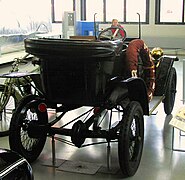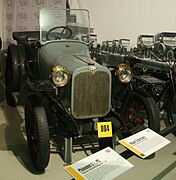Wanderer Puppet
| walker | |
|---|---|
|
Wanderer W1 (pre-series vehicle, 1911) in the traffic center of the Deutsches Museum in Munich
|
|
| W1 / W2 / W3 / W4 / W8 | |
| Sales designation: | Puppet |
| Production period: | 1912-1926 |
| Class : | Small car |
| Body versions : | Touring car |
| Engines: |
Petrol engines : 1.15-1.3 liters (8.8-14.7 kW) |
| Length: | 3100-3250 mm |
| Width: | 1330 mm |
| Height: | 1420-1500 mm |
| Wheelbase : | 2250-2395 mm |
| Empty weight : | 500-850 kg |
The Wanderer W1 5/12 PS , also called Wanderer Puppchen , was a small open touring car that the Wanderer-Werke from Chemnitz brought out in 1912. It had two seats in a row and two doors on the left side of the vehicle.
At the front there was a counter-controlled 4-cylinder in-line engine with 1.15 liter displacement, which produced 12 hp and powered the rear wheels via a 3-speed gearbox with a shift lever on the inside right.
The following year the Wanderer W2 5/15 PS appeared with a slightly larger engine (1.22 liters, 15 PS). In addition to the tandem arrangement of the seats (model H), there was also the two-seater with seats arranged side by side (model N). All models with seats next to each other only had a door on the left side.
In 1914 the third version appeared, the Wanderer W3 5/15 HP with an enlarged engine (1.29 liters, 15 HP). In addition to the two-seater, there was now also a three-seater (model Nv). The car was manufactured in this configuration until 1919.
The Wanderer W4 5/15 HP only appeared after the First World War . Again, the engine's displacement had been slightly increased. With an output of 17 hp, the displacement was 1.3 liters. In addition, the engine had hanging instead of the previously standing exhaust valves. The tandem two-seater (model H) was no longer offered.
In 1925 the car was revised again. The Wanderer W8 5/20 PS kept the same engine, which made 5 PS more. The two-seater model (model N) was omitted, but a four-seater was offered in addition to the three-seater.
In 1926 the production of the small car was stopped after approx. 9000 copies without a successor.
Rear view of the puppet in the Deutsches Museum , Munich
Wanderer W3 5/12, built in 1913 in the Museum for Saxon Vehicles in Chemnitz
Technical specifications
| Type | W1 (5/12 HP) | W2 (5/15 HP) | W3 (5/15 HP) | W4 (5/15 HP) | W8 (5/20 hp) |
| Construction period | 1912-1913 | 1913-1914 | 1914-1919 | 1919-1924 | 1925-1926 |
| Superstructures | T2T | T2T, T2 | T2T, T2, T3 | T2, T3 | T3, T4 |
| engine | 4 cyl. Row 4 bars | 4 cyl. Row 4 bars | 4 cyl. Row 4 bars | 4 cyl. Row 4 bars | 4 cyl. Row 4 bars |
| Valves | counteracted (IOE) | counteracted (IOE) | counteracted (IOE) | top steering (OHV) | top steering (OHV) |
| Bore × stroke | 62 mm × 95 mm | 64 mm × 95 mm | 64 mm × 100 mm | 64.5 mm × 100 mm | 64.5 mm × 100 mm |
| Displacement | 1147 cc | 1222 cc | 1286 cc | 1306 cc | 1306 cc |
| Horsepower) | 12 | 15th | 15th | 17th | 20th |
| Power kW) | 8.8 | 11 | 11 | 12.5 | 14.7 |
| consumption | 8 l / 100 km | 8 l / 100 km | 8 l / 100 km | 8.5 l / 100 km | 8.5 l / 100 km |
| Top speed | 70 km / h | 70 km / h | 70 km / h | 78 km / h | 78 km / h |
| Empty weight | 500 kg | 550-600 kg | 600-750 kg | 600-650 kg | 700-850 kg |
| Perm. total weight | 750 kg | 800-850 kg | 850-1000 kg | 850-900 kg | 1150-1300 kg |
| Electrics | 12 volts | 12 volts | 12 volts | 12 volts | 12 volts |
| length | 3100 mm | 3100-3250 mm | 3100-3250 mm | 3250 mm | 3250 mm |
| width | 1330 mm | 1330 mm | 1330 mm | 1330 mm | 1330 mm |
| height | 1500 mm | 1420 mm | 1420 mm | 1420 mm | 1420 mm |
| wheelbase | 2250 mm | 2250 mm | 2350 mm | 2395 mm | 2395 mm |
| Front / rear track | 1070 mm / 1070 mm | 1070 mm / 1070 mm | 1070 mm / 1070 mm | 1080 mm / 1080 mm | 1080 mm / 1080 mm |
| Turning circle |
- T2T = 2-seater touring car (tandem arrangement )
- T2 = 2-seater touring car
- T3 = 3-seater touring car
- T4 = 4-seater touring car
literature
- Werner Oswald : German Cars 1920–1945. All German passenger cars of the time . 10th edition. Motorbuch Verlag, Stuttgart 1996, ISBN 3-87943-519-7 .




